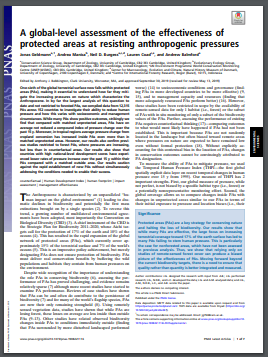
One-sixth of the global terrestrial surface now falls within protected areas (PAs), making it essential to understand how far they mitigate the increasing pressures on nature which characterize the Anthropocene. In by far the largest analysis of this question to date and not restricted to forested PAs, we compiled data from 12,315 PAs across 152 countries to investigate their ability to reduce human pressure and how this varies with socioeconomic and management circumstances. While many PAs show positive outcomes, strikingly we find that compared with matched unprotected areas, PAs have on average not reduced a compound index of pressure change over the past 15 y. Moreover, in tropical regions average pressure change from cropland conversion has increased inside PAs even more than in matched unprotected areas. However, our results also confirm previous studies restricted to forest PAs, where pressures are increasing, but less than in counterfactual areas. Our results also show that countries with high national-level development scores have experienced lower rates of pressure increase over the past 15 y within their PAs compared with a matched outside area. Our results caution against the rapid establishment of new PAs without simultaneously addressing the conditions needed to enable their success.












